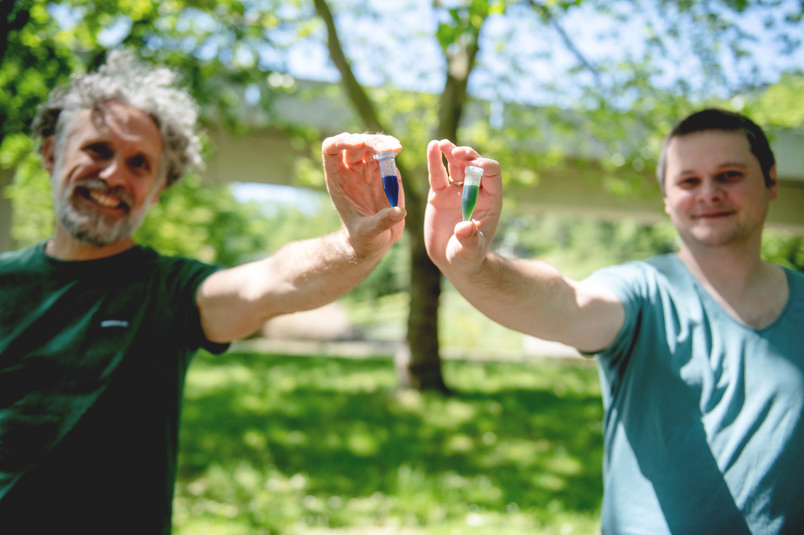Jun 3 2020
Protein complexes that take part in photosynthesis are prospective sources of renewable energy. But in technical applications, their efficiency is less than satisfactory. For instance, these proteins do not have the capability to convert green light into energy.
 Volker Hartmann (right) and Marc Nowaczyk have closed the green gap. Image Credit: © RUB, Marquard.
Volker Hartmann (right) and Marc Nowaczyk have closed the green gap. Image Credit: © RUB, Marquard.
A team of researchers at Ruhr-Universität Bochum (RUB) and the Israel Institute of Technology in Haifa has been successful in closing what is called the green gap by merging a photosynthesis protein complex with a light-collecting protein from cyanobacteria. The researchers pre-published their study online in the Journal of Materials Chemistry A on May 11th, 2020.
Imitating Plants, Algae, and Bacteria
The use of biosolar cells to convert sunlight into electrical energy is a novel idea. These cells are produced with biological components available from nature. Their core includes the so-called photosystems, which are huge protein complexes behind the energy conversion in cyanobacteria, algae, and plants.
Photosystem II (or PSII) has a key role in the process since it can make use of water as an electron source for producing electricity.
Cooperation so Far Unsuccessful in the Test Tube
However, as unique as PSII is, its efficiency is limited, because it can use merely a percentage of the sunlight. Cyanobacteria have solved the problem by forming special light-collecting proteins, i.e. phycobilisomes, which also make use of this light. This cooperation works in nature, but not yet in the test tube.
Marc Nowaczyk, Professor and Head, Molecular Mechanisms of Photosynthesis Project Group, RUHR Universitat Bochum
PSII is nearly inactive specifically with regards to the so-called green gap.
Super Complexes Use Twice as Many Photons of the Green Gap
Along with the research group under the guidance of Professor Wolfgang Schuhmann at RUB and the Israeli research group of Professor Noam Adir, Nowaczyk’s group has been successful in creating a two-component bioelectrode.
The major problem that the researchers faced was the functional interaction of the multiprotein complexes, a few of which were combined across different species.
These super complexes were stabilized by using short-chain chemical crosslinkers that set the proteins permanently at a brief distance from each other. Then, they incorporated the super complexes into suitable electrode structures.
We mastered this challenge by using customized, three-dimensional and transparent electrodes in combination with redox-active hydrogels.
Dr Volker Hartmann, Study Lead Author, RUHR Universitat Bochum
Using this design, the team was able to use twice as many photons inside the green gap than a system that lacks light collection complexes.
Promising Interim Stage
Scientists consider the assembly of protein complexes in the test tube as a promising interim stage in the development of biological solar cells. Thus, it would be possible to functionally combine the benefits of different species in semi-artificial systems.
Going forward, the team will mainly focus on maximizing the production and the lifetime of the biological components.
Funding
The study was financially supported by the Ruhr Explores Solvation Resolv Cluster of Excellence, the GRK 2341 Microbial Substrate Conversion Research School (Minco), which are supported by the German Research Foundation (DFG), and the German-Israeli research project Nano-engineered opto-bioelectronics with biomaterials and bio-inspired assemblies under the auspices of the DFG and the Israel Science Foundation.
Journal Reference:
Hartmann, V., et al. (2020) Improved quantum efficiency in an engineered light harvesting/photosystem II super-complex for high current density biophotoanodes. Journal of Materials Chemistry A. doi.org/10.1039/D0TA03444D.